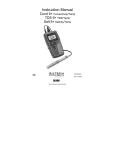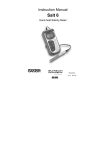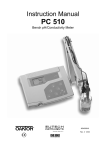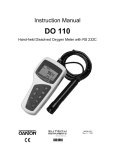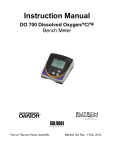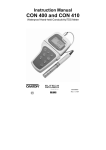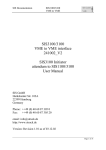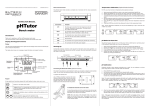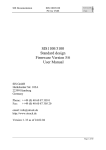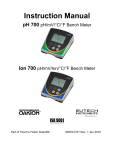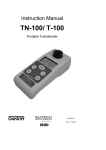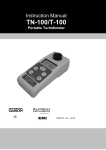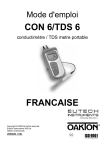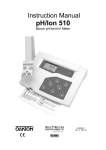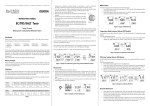Download EUTECH INSTRUMENTS CON 700 - REV 2 Instruction manual
Transcript
Instruction Manual CON 700 Conductivity/ºC/ºF Bench Meter Technology Made Easy ... Part of Thermo Fisher Scientific 68X541702 Rev. 1 Jan 2010 TABLE OF CONTENTS 1. INTRODUCTION .............................................................. 1 2. GETTING STARTED........................................................ 2 2.1 2.2 2.3 Keypad Functions ................................................................... 2 LCD Annunciators ................................................................... 3 Meter Connections .................................................................. 3 3. ELECTRODE INFORMATION ......................................... 4 4. CALIBRATION ................................................................. 4 4.1 4.2 4.3 4.4 4.5 4.6 Automatic or Manual Calibration ............................................. 4 Single or Multi-Point Calibration .............................................. 5 General Calibration Tips ......................................................... 6 Automatic Conductivity Calibration Procedure ........................ 6 Manual Conductivity & TDS Calibration Procedure................. 7 Temperature Calibration ......................................................... 7 5. MEASUREMENT.............................................................. 7 5.1 5.2 5.3 5.4 Taking Measurements............................................................. 7 Automatic and Manual Ranging .............................................. 8 HOLD Function ....................................................................... 8 Storing and Recalling Data ..................................................... 8 6. SETUP FUNCTIONS........................................................ 9 6.1 6.2 6.3 6.4 6.5 6.6 6.7 6.8 6.9 6.10 6.11 P1.0 CAL (Calibration) ............................................................ 9 P2.0 ELE (Electrode Information)............................................ 9 P3.0 ConF (Configuration) ...................................................... 9 P3.1 rdY (Ready / Stability Indicator) ...................................... 9 P3.2 ºC ºF (Celcius Or Fahrenheit) ......................................... 10 P3.3 AtC (Automatic Temperature Compensation) ................. 10 P3.4 tdS (Total Dissolved Solids factor).................................. 10 P3.5 t.CO (Temperature Coefficient)....................................... 10 P3.6 t.nr (Normalization Temperature in ºC) ........................... 11 ACAL (Automatic Conductivity Calibration)............................. 11 SPC (Single Point Calibration) ................................................ 11 6.12 CELL (Nominal Cell Constant) ................................................ 11 6.13 P4.0 rSt (Reset) ..................................................................... 12 6.14 P5.0 CLr (Clear Memory) ....................................................... 12 7. CALCULATING TDS CONVERSION FACTOR .............. 13 8. CALCULATING TEMPERATURE COEFFICIENTS........ 14 9. REPLACEMENTS AND ACCESSORIES........................ 15 10. TROUBLESHOOTING GUIDE......................................... 16 11. SPECIFICATIONS............................................................ 17 12. WARRANTY..................................................................... 18 13. RETURN OF ITEMS......................................................... 18 1. INTRODUCTION Thank you for purchasing our Con 700 series benchtop meter. This microprocessor-based meter is economical and simple to use. The design incorporates a large LCD for clear viewing, yet offers a small footprint to conserve space. The CON 700 measures conductivity or TDS, and temperature (ºC or ºF) simultaneously. Each meter includes a convenient slide-out card for quick reference. Some configurations include an electrode arm and metal bracket which can be easily attached to the left or right side of the meter according to your preference. The CON 700 series benchtop meter replaces our popular CON 510 series meter that was introduced in 2002. We take great pride in every instrument we manufacture and hope this one serves you well. 1 2. GETTING STARTED 2.1 Keypad Functions Powers the meter on and off. Upon power on, the meter automatically begins in the mode that was last used. Calibration and memory values are retained even if meter is unplugged. Toggle between available measurement modes— Conductivity with Temperature or TDS with Temperature. Also used to switch to Temperature calibration during Conductivity or TDS calibration mode. Press and hold for 5 seconds to enter SETUP mode. Toggles between measurement and calibration modes. In SETUP mode, returns user to the measurement mode. Confirms calibration values in CAL mode. Confirms selections in SETUP mode. Changes range and resolution in MEAS mode. View recalled values in memory mode. MI (Memory Insert) stores values into memory. Increase value. Scroll up in SETUP & CAL modes. MR (Memory Recall) recalls values from memory Decrease value. Scroll down in SETUP & CAL modes. Freezes measured reading. Press again to resume live reading. 2 2.2 LCD Annunciators 2.3 Meter Connections CON/ Temp DC 8-pin DIN connection for 2-cell Con/TDS/Temp electrode Power supply 3 3. ELECTRODE INFORMATION The CON700 includes an electrode with a nominal cell constant of k = 1.0, built-in temperature sensor, and 1 meter cable. The Ultem body housing has good chemical resistant properties. The electrode design offers fast temperature response and reduces air entrapment, ensuring accurate, repeatable, and stable readings. The wetted materials of the probe include: Polyetherimide (Ultem) – protective probe guard Polybutylterphalate (Valox) – sensor housing Stainless Steel (SS 304) – 2 bands The protective probe guard can be removed temporarily for cleaning however it must be re-attached during measurement and calibration. Erroneous results will occur while the probe guard is removed. Always immerse the probe beyond upper steel band for best results. Use the fill line on the outside of the probe guard for reference. 4. CALIBRATION 4.1 Automatic or Manual Calibration The CON 700 is capable of automatic or manual calibration for conductivity, and manual calibration for TDS. In the automatic calibration mode, the meter will automatically select one of (4) conductivity calibration standard values depending on the range and normalization temperature being used (TABLE 1). If you only use calibration standards that are listed in TABLE 1, automatic calibration is recommended. If you intend to calibrate with one or more standards that are not listed in TABLE 1, the CON 700 must be set for manual calibration instead. 4 The factory default is automatic conductivity calibration. See Section 6.10 to change this setting. There is no automatic calibration value available for conductivity range 1. Range # r1 Conductivity Range TABLE 1 Automatic Calibration Values Normalization Temperature 0.00 – 20.00 μS 25 ºC 20 ºC None None r2 20.1 – 200.0 μS 84 μS 76 μS r3 200.1 – 2000 μS 1413 μS 1278 μS r4 2.01 – 20.00 mS 12.88 mS 11.67 mS r5 20.1 – 200.0 mS 111.8 mS 102.1 mS Range # TDS Range (using 0.5 TDS factor) Automatic Calibration Values r1 0 – 10.00 ppm r2 10.1 – 100.0 ppm none none r3 101 – 1000 ppm none r4 1.01 – 10.00 ppt none r5 10.1 – 100 ppt none 4.2 Single or Multi-Point Calibration Use Single-Point Calibration to apply a single calibration value across all ranges. Use Multi-Point Calibration for individual calibration in each range. This will restrict an individual calibration so that it is applied to one range only. When using multi-point calibration, perform a calibration in each range that you expect to use for best results. 5 The factory default is Single-Point Calibration. See Section 6.11 to change this setting. 4.3 General Calibration Tips For best results, periodic calibration with known accurate standards is recommended. A maximum of one calibration point per range can be performed. If multiple calibration points are used in the same range, the most recent one will replace the previous one. When the electrode is replaced, it is best to clear the calibration to the factory default values (see Section 6.13). Rinse or immerse the probe before calibration and between samples with clean water (deionized water is ideal). The CON 700 has non-volatile memory which will retain all calibration values, as well as meter settings and memory values upon meter shut down or unexpected power loss. To protect from erroneous calibrations, the allowable tolerance is ±40% of the factory default value. Low conductivity standard solutions (less than 20 µS) are unstable and are very temperature dependent. As a result, reproducible calibration results are challenging in lowest measurement range #1 (0.00 to 20.0 µS). 4.4 Automatic Conductivity Calibration Procedure 1) Press 2) Dip the electrode into the conductivity standard and press . Provide stirring for best results. The primary display will show the factory default value, while the secondary display will lock on the appropriate automatic standard value from TABLE 1. 3) 4) as needed to select conductivity (μS or mS). When the READY indicator appears, press to accept. The primary reading will flash briefly before returning to measurement mode upon successful calibration. 6 4.5 Manual Conductivity & TDS Calibration Procedure 1) as needed to select conductivity (μS or mS) or TDS Press (ppm or ppt) calibration. 2) Dip the electrode into the calibration standard and press . Provide stirring for best results. The primary display will show the current reading, while the secondary display will be the factory default value. Adjust the 3) temperature reading using or . Press to accept. The primary reading will flash briefly before returning to measurement mode upon successful calibration. 4.6 Temperature Calibration The thermistor sensor used for automatic temperature compensation and measurement is accurate and stable, so frequent calibration isn’t required. Temperature calibration is recommended upon probe replacement, whenever the temperature reading is suspect, or if matching against a certified thermometer is desired. 1) Place the probe into a solution with a known accurate temperature such as a constant temperature bath. followed by . The primary display shows the 2) Press measured temperature while the secondary display shows the factory default temperature. 4) Adjust the temperature using or . Press to accept or º to cancel. The meter allows an adjustable maximum value of ± 5 C º (or ± 0.9 F) from the factory default temperature. 5. MEASUREMENT 5.1 Taking Measurements 1) Rinse the electrode with de-ionized or distilled water before use to remove any impurities. Gently shake excess water droplets. 7 2) Dip the probe into the sample beyond the upper steel band (utilize the fill line on the outside of the probe guard for reference). 3) Allow time for the reading to stabilize. Note the reading on the display. The clear yellow protective probe guard must be attached during measurement. Erroneous results will occur while the probe guard is removed. 5.2 Automatic and Manual Ranging The CON 700 automatically selects the optimum range in which your readings appear. Refer to TABLE 1 for a list of the available ranges. . MEAS will flash, indicating To turn-off automatic ranging, press that manual ranging is active. To manually select the next range, press again. After range 5, automatic ranging is resumed. For example, a reading of 465 μS will automatically settle in range 3. Using manual range advancement this will read as 0.47 mS in range 4, and 0.5 mS in range 5. For best resolution, use auto-ranging. 5.3 HOLD Function For prolonged observation of a reading, press during measurement mode to freeze the display. The “HOLD” indicator will display when the reading is held. To release the held value and resume measurement, press memory by pressing again or insert the held value into . 5.4 Storing and Recalling Data The CON 700 can retain up to 100 data points into memory for later retrieval. 1) In the measurement mode, press to insert the measured value into memory. The stored memory location value (StO) is briefly displayed. 8 2) To recall data from memory, press . The location of the most recent stored data is displayed first. Press location of the desired data, then press or to select the to accept. 3) Press to return to the stored data location. Press to return to measurement mode. To erase stored data, see Section 6.14. 6. SETUP FUNCTIONS Use the set up mode to customize your instrument operation. During measurement, press and hold mode. Press or for 5 seconds to enter SETUP to change programs or change options. Press to select the program or confirm selection. Press to go back one level or return to measurement mode. 6.1 P1.0 CAL (Calibration) to view stored calibration points in each range. Press 6.2 P2.0 ELE (Electrode Information) to view cell efficiency in each range. Press 6.3 P3.0 ConF (Configuration) to access set-up programs 3.1 thru 3.9. Press 6.4 P3.1 rdY (Ready / Stability Indicator) Press . Press or Auto HOLd. to choose READY “On”, READY “OFF”, or 9 Press to confirm. 6.5 P3.2 ºC ºF (Celcius Or Fahrenheit) Press . Press or Press to select ºC or ºF. to confirm. 6.6 P3.3 AtC (Automatic Temperature Compensation) Press . Press or Press to select “Yes” or “No”. to confirm. 6.7 P3.4 tdS (Total Dissolved Solids factor) Press . Press 1.00). or Press to select the desired TDS factor (.40 to to confirm. 6.8 P3.5 t.CO (Temperature Coefficient) The temperature coefficient is the amount of change in conductivity per degree temperature (% per ºC). The CON 700 is factory set to a temperature coefficient of 2.1 % per ºC. For most applications this will provide good results. The meter allows adjustment from 0.0 to 10.0. TIP: Select 0.0% for uncompensated measurements. The temperature will be measured by the electrode and displayed in measurement mode—without compensation. See Section 8 – Calculating Temperature Coefficients. 10 Press . Press or Press to select the desired value (0.00 to 10.0). to confirm. 6.9 P3.6 t.nr (Normalization Temperature in ºC) When Automatic Temperature Compensation is used, measurements are adjusted by the temperature coefficient to the normalization temperature. The default value is 25 ºC. Press . Press or Press to select the desired value (15.0 to 30.0). to confirm. 6.10 ACAL (Automatic Conductivity Calibration) See Section 4.1 for more details on Automatic Conductivity Calibration. Press . Press or Press to select “Yes” (Automatic) or “No” (Manual). to confirm. 6.11 SPC (Single Point Calibration) See Section 4.2 for details on Single Point & Multi Point Calibration. Press . Press or Press to select “Yes” (Single) or “No” (Multi). to confirm. 6.12 CELL (Nominal Cell Constant) The CON 700 includes a probe with a nominal cell constant (k) of 1.0. Use probes with k = 0.1 and 10 (sold separately) for improved 11 performance in extreme sample ranges. Use this setup function to change the cell constant if necessary. Meter default is 1.0 to match the included probe. k = 0.1 ideal for low measurements <20 µS (<10 ppm). k = 1.0 ideal for mid-range measurements k = 10 ideal for high measurements >20 mS (>10 ppt). Press . Press or Press to select 0.1, 1.0, or 10.0 to confirm. 6.13 P4.0 rSt (Reset) Press . Press or to select “Yes” (Reset) or “No” (Cancel). If “Yes”, press or to select “Cal” (calibration reset only) or “FCt” (complete reset to factory default settings). Press to confirm. 6.14 P5.0 CLr (Clear Memory) Press . Press or Press to select “Yes” (Erase memory) or “No”. to confirm. 12 7. CALCULATING TDS CONVERSION FACTOR You can calibrate TDS using the value of the calibration standard solution at a standard temperature such as 25 ºC. To determine the conductivityto-TDS conversion factor use the following formula: Factor = Actual TDS ÷ Actual Conductivity @ 25 ºC Actual TDS: Value from the solution bottle label or as a standard made using high purity water and precisely weighed salts. ppm = milligram of salt(s) per liter of water = mg/L ppt = gram of salt(s) per liter of water = g/L Actual Conductivity: Value measured using a properly calibrated Conductivity/Temperature meter. Both the Actual TDS and the Actual Conductivity values must be in the same magnitude of units. For example, if the TDS value is in ppm the conductivity value must be in µS; if the TDS value is in ppt the conductivity value must be in mS. Check your factor by multiplying the conductivity reading by the factor in the above formula. The result should be in TDS value. When the TDS factor is set to 1.0, Conductivity = TDS. 13 8. CALCULATING TEMPERATURE COEFFICIENTS To determine the temperature coefficient of your sample solution use this formula: Where: tc = Temperature coefficient 25 = 25 ºC CT1 = Conductivity at Temp 1 CT2 = Conductivity at Temp 2 T1 = Temp 1 T2 = Temp 2 NOTE: A controlled temperature water bath is ideal for this procedure. 1. 2. 3. Immerse the probe into a sample of your solution and adjust the temperature coefficient to 0% (that is, no compensation) by following instructions as described in Section 6.8. Wait for 5 minutes. Note T1 and CT1 (conductivity at T1). Condition the sample solution and probe to a temperature (T2) that is about 5 ºC to 10 ºC different from T1, and note the conductivity reading CT2. NOTE: Record your results for future reference. Ideally T1 and T2 should bracket your measurement temperature, and should not differ by more than 5 ºC. 4. 5. Calculate the temperature coefficient of your solution according to the formula shown above. Enter the calculated temperature coefficient into the meter. The calculated temperature coefficient will now be applied to all the meter readings. 14 9. REPLACEMENTS AND ACCESSORIES Part number Ordering Code Item Description Eutech Instruments CON 700 Benchtop with electrode and integral stand,100/240 VAC ECCON70043S Replacement electrode, k = 1.0 Oakton Instruments 35411-00 CONSEN9501D 35608-74 Epoxy/platinum electrode, k = 0.1 - 35608-72 Glass/platinum electrode, k = 1.0 - 35608-76 Epoxy/platinum electrode, k = 10.0 - 35608-78 60X030130 35615-07 SMPS, 100/240 VAC, 9V, 6W power adapter 10 μS, (20) x 20mL Sachets ECCON10BS 35653-09 84 µS, 480 mL bottle* ECCON84BT 00653-16 100 μS, 480 mL bottle ECCON100BT - 447 μS, 480 mL bottle ECCON447BS 00653-47 500 μS, 480 mL bottle ECCON500BT - 1413 μS, 480 mL bottle* ECCON1413BT 00653-18 1413 μS, (20) x 20mL Sachets* ECCON1413BS 35653-11 2764 μS, 480 mL bottle ECCON2764BT 00653-20 2764 μS, (20) x 20mL Sachets ECCON2764BS 35653-12 5.0 mS, 480 mL bottle ECCON5000BT - 12.88 mS, 480 mL bottle* ECCON1288BT 00606-10 15 mS, (20) x 20mL Sachets ECCON15000BS 35653-13 111.8 mS, 480 mL bottle* ECCON1118BT - *Automatic Calibration Standard Value at 25 ºC 15 10. TROUBLESHOOTING GUIDE PROBLEM No display CAUSE SOLUTION Main power not switched on. AC Adapter socket not inserted properly. a) Switch on the power supply. “Ur” (Under range) Measured value is out of range. Check electrode is connected. “Or” (Over range) Electrodes not connected. Recalibrate the meter. Electrode clogged, dirty or broken. Confirm measurement condition. in primary or secondary display b) Re-insert AC Adapter. Clean or replace electrode. Meter not calibrated. Treat samples to bring within meter measuring range. Wrong temp value. Reset meter. Slow response Dirty electrode. Clean the electrode. Temperature of sample is changing. Allow temperature to stabilize. Meter not responding to key press Manual HOLD or Auto HOLD is active. Worn keypad. Press to deactivate manual HOLD. See Section 6.4 to disable Auto Hold feature if enabled. Contact Technical Service. Secondary display continually scrolls Invalid key; Button is not functional in the current operation mode. Press alternate key. Select valid key depending on current mode. Conductivity calibration standard is not within 40% of expected value during automatic calibration. Ensure electrode guard has not been removed. 16 Use fresh or different calibration standard. 11. SPECIFICATIONS Conductivity Range TDS Range (0.5 TDS factor) 0 to 20.00, 200.0, 2000 µS 0 to 20.00, 200.0 mS 0 to 10.00, 100.0, 1000 ppm 0 to 10.00, 100.0 ppt (max 200.0 ppt @ 1.0 TDS factor) Resolution 0.05 % Full Scale Accuracy ±1% Full Scale Temperature Range (Meter) 0.0 to 100.0 ºC / 32.0 to 212.0 ºF Compensation Type & Range Automatic with supplied cell or Manual. 0.0 to 100 ºC / 32.0 to 212.0 ºF, 0.0 to 80 ºC / 32.0 to 176.0 ºF with supplied cell 0.1 ºC / ºF Resolution ± 0.5ºC / ± 0.9ºF Accuracy Calibration Offset in 0.1 º increments; Offset range: 5 ºC / 9 ºF Coefficient 0.0 to 10.0% per ºC Normalization Cell Constant TDS Factor Calibration points 15.0 to 30.0 ºC (adjustable) 0.1, 1.0, 10.0 (selectable) 0.40 to 1.00 (adjustable) Automatic (4 points); Maximum 1 per range Manual (5 points); Maximum 1 per range Auto-ranging Yes Hold Function Yes Memory 100 data sets Input Power Dimensions (mm) 8-pin DIN AC/DC 9V, 6W Adapter (100/240 VAC, 50-60Hz) meter only = 175 (L) x 155 (W) x 69 (H) 17 12. WARRANTY This meter is supplied with a warranty against significant deviations in material and workmanship for a period of THREE years from date of purchase whereas probe with a SIX month warranty. If repair or adjustment is necessary and has not been the result of abuse or misuse within the designated period, please return – freight prepaid – and correction will be made without charge. Eutech Instruments/Oakton Instruments will determine if the product problem is due to deviations or customer misuse. Out of warranty products will be repaired on a charged basis. The warranty on your instrument shall not apply to defects resulting from: 13. Improper or inadequate maintenance by customer Unauthorized modification or misuse Operation outside of the environment specifications of the products RETURN OF ITEMS Authorization must be obtained from our Customer Service Department or authorized distributor before returning items for any reason. A “Return Goods Authorization” (RGA) form is available through our authorized distributor. Please include data regarding the reason the items are to be returned. For your protection, items must be carefully packed to prevent damage in shipment and insured against possible damage or loss. Eutech Instruments will not be responsible for damage resulting from careless or insufficient packing. A restocking charge will be made on all unauthorized returns. NOTE: Eutech Instruments Pte Ltd /Oakton Instruments reserve the right to make improvements in design, construction, and appearance of products without notice. 18 For more information on our products, please contact our channel partner or visit our websites listed below: Oakton Instruments 625 E Bunker Court Vernon Hills, IL 60061 USA Tel: (1) 888-462-5866 Fax: (1) 847-247-2984 [email protected] www.4oakton.com Eutech Instruments Pte Ltd Blk 55, Ayer Rajah Crescent, #04-16/24 Singapore 139949 Tel: (65) 6778 6876 Fax: (65) 6773 0836 [email protected] www.eutechinst.com Distributed by: Part of Thermo Fisher Scientific
























